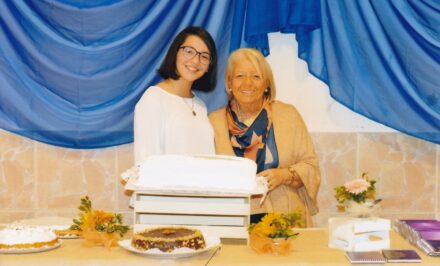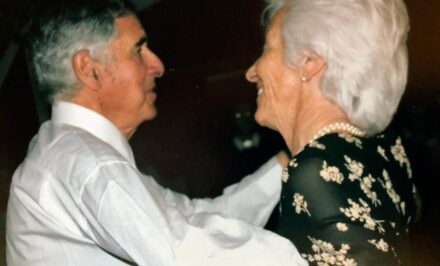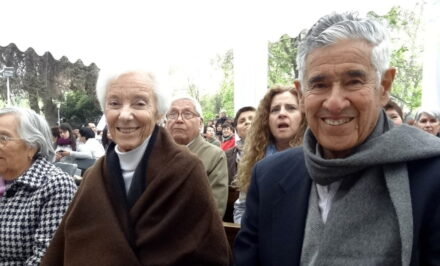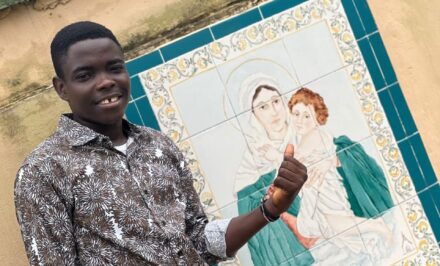 CHILE, Juan Enrique Coeymans Avaria, Camencha Zabala de Coeymans. On January 7, 2011, , Father Ernesto Durán Díaz, the first Chilean Schoenstatter and one of the founders of the Movement in Chile, died at the age of 94.
CHILE, Juan Enrique Coeymans Avaria, Camencha Zabala de Coeymans. On January 7, 2011, , Father Ernesto Durán Díaz, the first Chilean Schoenstatter and one of the founders of the Movement in Chile, died at the age of 94.
He was a diocesan seminarian when he Providentially met a Pallottine Father and he entered that community. He was sent to continue his studies in Germany. There he met the Founder and the Movement and became a Schoenstatter in the 1930’s. Therefore, he is the first Chilean Schoenstatter. He returned to Chile at the height of WWII, but not without first having had problems with the Hitler regime. He belonged to the second generation of German Pallottine Schoenstatters, the Cenacle generation. He was ordained a priest in 1942, beginning his priestly work at the Colegio Federico Errázuriz in Santa Cruz, Colchagua. There he conquered one of the first Chilean youths for the Movement, Father Rafael Fernández from Andraca. Later he is transferred to Santiago where he performs his apostolate in different chaplaincies, among them the Youth Catholic Action.
His life
 In 1950, he begins the formation of youth groups under his spiritual direction in the Schoenstatt Movement and he is able to conquer numerous and valuable university youths. Among them are the major portion of the present Schoenstatt Fathers of the Chilean founding generation. Along with Saint Alberto Hurtado, he has been one of the priests most fruitful with priestly vocations in the history of the Church in Chile. He forms a large legion of university students who were the basis of the numerous priestly vocations which came forth.
In 1950, he begins the formation of youth groups under his spiritual direction in the Schoenstatt Movement and he is able to conquer numerous and valuable university youths. Among them are the major portion of the present Schoenstatt Fathers of the Chilean founding generation. Along with Saint Alberto Hurtado, he has been one of the priests most fruitful with priestly vocations in the history of the Church in Chile. He forms a large legion of university students who were the basis of the numerous priestly vocations which came forth.
In the mid 1950’s, pedagogical controversies are unleashed on the structure of the Movement and on the Mission of May 31st , between him and Father Benito Schneider. These are the origin of the division with which our foundation was tested in its beginnings. In mid December of 1960, he leaves Chile and first works for some years in Argentina. He then works for more than 30 years in New York. At the end of the 1970’s, he leaves the Pallottines and enters the clergy of the Diocese of Brooklyn. He performs a fruitful parrish ministry in that New York neighborhood, and returns to Chile at the beginning of the 1990’s. In Chile, he lives a tranquil retired life, receiving in his apartment in Providencia persons who wanted to talk to him, go to confession and seeking spiritual direction.
Through his life, the Lord gave us great gifts. Three aspects should be highlighted:
Awareness of being a forerunner
 First, the great awareness of being a forerunner. He identified himself greatly with Saint John the Baptist, and prophetically, on the day of his ordination he alludes to it. He felt that his labor would be to only prepare the way and to announce what would come, that is, his spiritual children for the creation and consolidation of the Movement. He saw the figure of John the Baptist as a preparer of the way, but also the figure of John the Baptist as a robust man who required much of himself – sober and simple, but also a man with prophetic strength, announcing the Kingdom, conversion and change in persons. But he also felt he was a forerunner of the Mission of the 31st of May. No one like him was as enthused for the Mission and he transmitted it to his spiritual children. His talks on the 31st of May were profound and beautiful and especially captivating. He was the great apostle of May 31st and of much which he discovered: the importance of the Daughter Shrines, the need for the inculturation of Schoenstatt so that it would no longer be German and become a universal Movement. This cost him profound misunderstandings and bad experiences. It is true that he fought about structural things which were not at the core of the Mission and for which there was no reason (the “life groups” as permanent communities in the organizational order) but there is something deep in them which persists: love attachments should always be preserved no matter where we are and our brothers and sisters in youth groups – even though we may join other communities – they are and we will love them as group brothers and sisters forever.
First, the great awareness of being a forerunner. He identified himself greatly with Saint John the Baptist, and prophetically, on the day of his ordination he alludes to it. He felt that his labor would be to only prepare the way and to announce what would come, that is, his spiritual children for the creation and consolidation of the Movement. He saw the figure of John the Baptist as a preparer of the way, but also the figure of John the Baptist as a robust man who required much of himself – sober and simple, but also a man with prophetic strength, announcing the Kingdom, conversion and change in persons. But he also felt he was a forerunner of the Mission of the 31st of May. No one like him was as enthused for the Mission and he transmitted it to his spiritual children. His talks on the 31st of May were profound and beautiful and especially captivating. He was the great apostle of May 31st and of much which he discovered: the importance of the Daughter Shrines, the need for the inculturation of Schoenstatt so that it would no longer be German and become a universal Movement. This cost him profound misunderstandings and bad experiences. It is true that he fought about structural things which were not at the core of the Mission and for which there was no reason (the “life groups” as permanent communities in the organizational order) but there is something deep in them which persists: love attachments should always be preserved no matter where we are and our brothers and sisters in youth groups – even though we may join other communities – they are and we will love them as group brothers and sisters forever.
The transmission of love to Mary as a way toward a full, vital understanding of Christ
In the second place, the fruitful, persevering and profound transmission of love to Mary as a way toward a full, vital understanding of Christ. For him, the Covenant of Love was something alive and permanent and the attachment to the Shrine was a legacy for his spiritual children which accompanied us always. Our Father and Founder said on one occasion: “few have understood the existential projection of the Covenant of Love as Ernst (Ernesto).” His retreats of the 1950’s – with the complete tone of that period – will be, now that he has departed, a spectacular rediscovery of the enormous dimensions of the Covenant of Love in personal and community life.
A Father of mercies
The third: the Father of mercies: he made all of us – from that era – enter into the unforeseen dimensions of the merciful love of God. He made us turn around our ancient Catholic conscience that “we have to behave so that God can love us,” for the new slogan: “because God loves us, we behave.” He valued greatly the Sacrament of Penance and he dedicated innumerable hours to it. He knew that there – in the source of graces in which the forgiveness of God is received – there was a Sacrament of the Father who renewed us in our awareness as children. Through his advice, understanding and welcoming, we felt the merciful love of God in our lives.
A pillar of Bellavista and of the Chilean Schoenstatt has departed. History, more objective than we – poor short-sighted mortals – will harvest his immense legacy to the Church and to Schoenstatt. Behind his life is the mystery of all forerunners: a life of proposals which generate contradictions, a life of the silent cross and a life of blessings.
On the day of his ordination, he chose a sacred phrase from the book of Numbers (NU 23,20): “It is a blessing I have been given to pronounce; a blessing which I cannot restrain.” Now from Heaven, with his dear Blessed Mother and the Lord – whom he served faithfully – he can fulfill fully his task of blessing.
Translation: Carlos Cantú, Schoenstatt Family Federation, La Feria, Texas USA 01102011














I was taught the German language (year one and year two) by P. Ernesto at Bishop Eustace Preparatory School in Pennsauken, NJ in 1967, 1968. I thought he was an open man, but do not agree with his estimation of the Pallottines. I have many letters from P. Ernesto (dating from 1967 to 2006), and he always defended the Pallottines when I would question him on their inability to bring more men to the Holy Priesthood.
In many respects, the Pallottines are exactly what one does not want to see in sacerdotal life. I can say this as a consecrated Bishop in the Eastern Orthodox autocephaly without fear of retribution, discipline, or humiliation. The Pallottines were dishonest men when I knew them at Eustace,with the exception of Ernesto, who did not have the power to keep them in check or monitor their falsehoods in speech and behavior.
I look at the Italian legation of the Pallottines in New York City and Sarasota, Florida and think, Good God, could they not have done better than what they have? They hid well their pedophilia problems (which any look at bishopaccountability.org will flag for those interested). Their reaction to everything was to never respond to any questions. They hid and kept everything silent, much as Satan does when he tempts you to fornication in ways you never suspected.
Ernesto left the Pallottines, however, and this I found fascinating. It was so unlike his behavior to simply move on from what he was doing. Something very serious must have forced his movement out of this body of somewhat suspect men to Brooklyn’s All Saints Church on Throop Avenue in Brooklyn. I am grieved that the Tablet, the Brooklyn Diocese newspaper, had nothing about his death when he died.
I am probably, then, one of the very few men alive who knew Ernesto as I did and who was in contact with him to the extent that I was. I am sure that he is in heaven, given his wonderful and inspirational devotion to the Mother of God. It is that devotion that I take from him as his greatest example of Priesthood and which I myself treasure as the Priest’s path to Jesus.
The Pallottines, however, are a different story, and Ernesto’s exodus from that Society I will have to discuss with him in another life. In that life I am sure that neither silence nor lies shall cover what the Pallottines did in the years Ernesto was at Bishop Eustace Prepatory.
In Xto,
Most Reverend Chrysostomos Robert Geis, S. S. B.
Commemoration of the Holy Martyr Juliana of Nicomedia